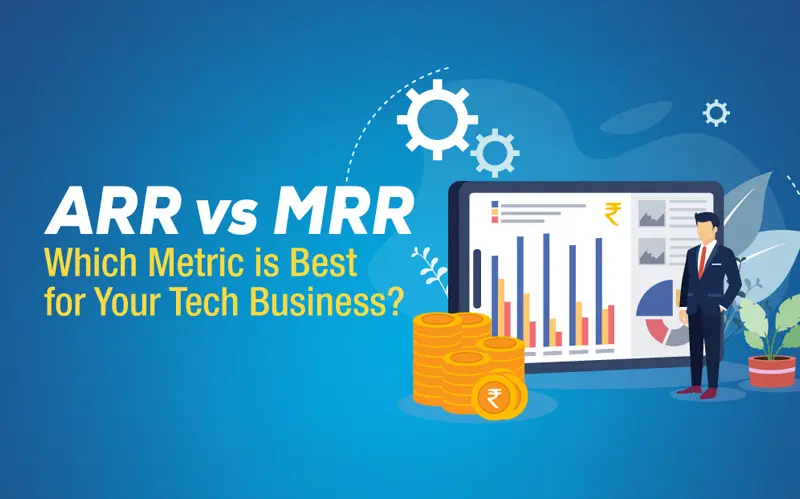

ARR vs MRR: Which Metric is Best for Your Tech Business?
Published at: Mar 14,2023

Monthly recurring revenue (MRR) is the amount of predictable revenue your Tech business earns each month from customers, and annual recurring revenue (ARR) is the annualized amount of predictable revenue your company will generate.
ARR and MRR both are the key metrics used by SaaS or subscription businesses that have term subscription agreements, meaning there is a defined contract length. These metrics will also be useful for IT companies or other service-based companies as they work on a monthly subscription model.
Both ARR and MRR are really useful for keeping track of your company’s health, growth, and success and they can be used to make accurate future decisions and action plans for your company.
What is MRR?
MRR stands for Monthly Recurring Revenue. It is a normalized metric that tells the anticipated revenue you can generate per month from paying customers. Unlike product-based companies, SaaS businesses that utilize a subscription model do not rely on one-off sales. Instead, their revenue model depends on a consistent income stream from both new and existing subscribers.
It is also advantageous for companies in their early stages, as it enables them to adjust their operations and products more efficiently, leading to faster growth.
Importance of MRR for your Tech business
The MRR is very important for SaaS companies because it provides monthly trends.
MRR serves as an indicator of monthly revenue, which makes it a useful tool for financial planning and forecasting purposes. It enables you to estimate upcoming cash flow.
It’s suitable for assessing the growth rate and momentum of the company. The company is doing well if the MRR is steadily rising. If it is falling, you need to take corrective measures, like reducing churn.
MRR helps you calculate the Customer Lifetime Value (CLTV) for all your clients. By concentrating on the most valuable clients and delivering excellent value, you can increase customer loyalty and make it challenging for them to switch to competitors.
Calculation of MRR
Multiply the monthly subscribers by the average revenue per user (ARPU).
MRR = Number of subscribers under a monthly plan * ARPU
For subscriptions under annual plans, MRR is calculated by dividing the annual plan price by 12 and then multiplying the result by the number of customers on the annual plan.
What is ARR?
ARR represents the normalized value of a business’s recurring revenue earned from subscribers over a year. This metric is useful in predicting the total revenue that a business can expect to generate annually.
It includes the ARR generated from new sales and upgrades, retention through renewals, as well as the loss of revenue due to customer churn, cancellations, and downgrades.
B2B companies that offer multi-year subscription plans often prefer to use ARR as a performance metric.
Importance of ARR for your Tech business
ARR indicates whether the total revenue is trending upwards or downwards, and the underlying causes for such changes. So, you can focus on and improve specific areas to increase your income.
You can plan major expenses better. This encompasses various expenses such as employee compensation, strategic hiring, increased investment in marketing and sales, as well as equipment procurement or upgrades.
You can forecast revenues and cash flow more accurately.
Companies with a good ARR attract investors and buyers.
ARR is specifically useful in measuring momentum in areas such as sales, renewals, upgrades, and loss of momentum.
ARR is more popular with businesses with lower transaction volume and high transaction value.
Calculation of ARR
ARR can be calculated by dividing the contract value of the subscription by the length of the contract in years if you bill customers on a yearly basis.
ARR= Value of Subscription Contract/No of Contract Years
If customers are billed monthly, then the ARR can be calculated by dividing the contract value of the subscription by the length of the contract in months. ARR can also be calculated using the MRR (which is the revenue generated per month) with the following formula.
ARR=MRR * 12 (months)
ARR Vs MRR: Which One Should You Use?
ARR and MRR are very similar. The primary distinction lies in the duration over which revenues are normalized, either on a monthly or annual basis. Hence, ARR provides a long-term or “big picture” view of company performance, and MRR provides a shorter-term view.
ARR is a suitable metric for your business if your subscription model spans a minimum of one year, and a significant number of customers have committed to a one-year or multi-year contract.
MRR is helpful for short-term planning and measuring the impact of recent changes. ARR assists in projecting the long-term growth potential and future scale of your business.
ARR provides an overall view of your business. MRR takes a more in-depth look.
Conclusion
We can help you in calculating the MRR & ARR for your Tech business. We will help you to solve all the accounting problems which IT companies face on a daily basis.
If you’re considering outsourcing your accounting needs, your search for a reliable partner ends here. Ease Up can help you. We are the leading accountants for Technology companies & Tech startups in India. We have served various Tech companies and helped them improve their accounting and bookkeeping tasks.

CA Aditya Chokhra
July 05, 2025

Empower Your Business with Expert Financial Consulting
Latest Post
Leave a Reply

Contact us and subscribe to our newsletter to receive expert advice and industry updates.

Mumbai: A-116-1st Floor, Super Shopping Complex, Bajaj Cross Road, Near Kandivali Station, Kandivali (W), Mumbai 400067.
Ahmedabad: 315 Abhinav Arcade, Nr. Kothawala Flats, Paldi, Ahmedabad 380007.
Pune: B 602, The Onyx, Pink City Road, Shankar Kalat Nagar, Pune 411057.
Gurgaon: 1123 JMD Megapolis, Sector 48, Gurgaon - 122018, Haryana.
Bhilwara: C - 147, Shashtri Nagar, Bhilwara (Raj).
Surat: 6019, World Trade Center, Ring Road, Surat - 395002.
Copyright © 2025 Easeupnow. All rights reserved.





















